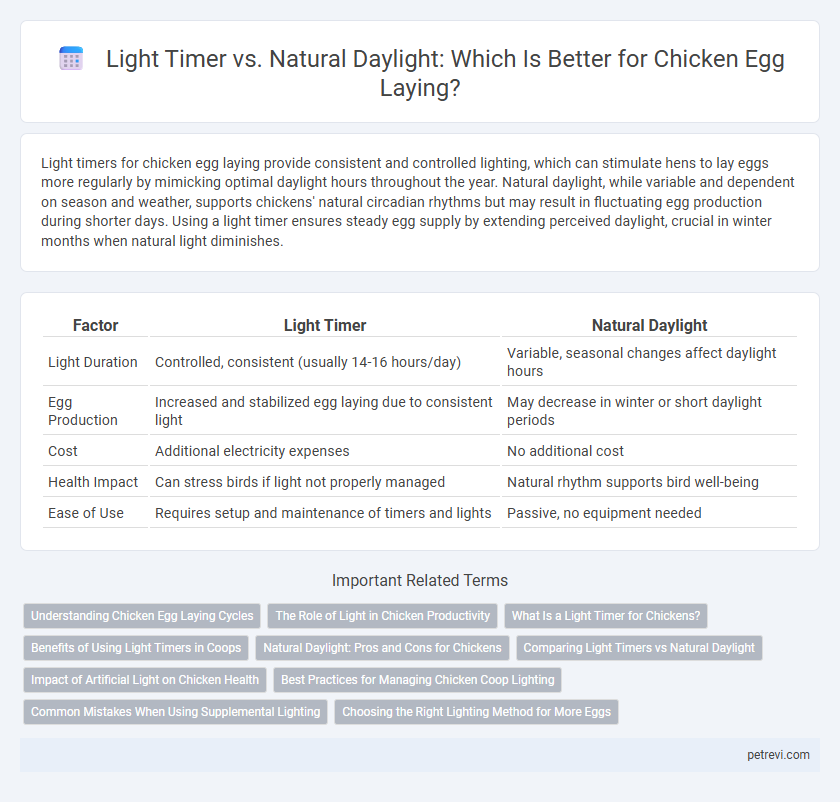Light timers for chicken egg laying provide consistent and controlled lighting, which can stimulate hens to lay eggs more regularly by mimicking optimal daylight hours throughout the year. Natural daylight, while variable and dependent on season and weather, supports chickens' natural circadian rhythms but may result in fluctuating egg production during shorter days. Using a light timer ensures steady egg supply by extending perceived daylight, crucial in winter months when natural light diminishes.
Table of Comparison
| Factor | Light Timer | Natural Daylight |
|---|---|---|
| Light Duration | Controlled, consistent (usually 14-16 hours/day) | Variable, seasonal changes affect daylight hours |
| Egg Production | Increased and stabilized egg laying due to consistent light | May decrease in winter or short daylight periods |
| Cost | Additional electricity expenses | No additional cost |
| Health Impact | Can stress birds if light not properly managed | Natural rhythm supports bird well-being |
| Ease of Use | Requires setup and maintenance of timers and lights | Passive, no equipment needed |
Understanding Chicken Egg Laying Cycles
Chicken egg laying cycles are regulated by light exposure, with natural daylight providing gradual changes that align with their circadian rhythm, promoting consistent laying patterns. Light timers offer controlled artificial lighting, extending day length to stimulate laying during shorter days by mimicking longer daylight hours. Understanding these cycles helps optimize egg production by balancing photoperiod management with chickens' natural biological rhythms.
The Role of Light in Chicken Productivity
Light exposure significantly influences chicken egg production by regulating their reproductive hormones through the pineal gland. Artificial light timers provide consistent and extended light periods, enhancing laying frequency compared to variable natural daylight hours. Controlled lighting schedules optimize the photoperiod, ensuring peak productivity regardless of seasonal changes.
What Is a Light Timer for Chickens?
A light timer for chickens is an automated device that controls the duration and intensity of artificial light exposure in a chicken coop to regulate egg production. By extending daylight hours consistently, it stimulates hens' reproductive cycles, promoting steady egg laying even during shorter, darker months. This tool helps maintain predictable egg output, improving flock productivity compared to relying solely on natural daylight variations.
Benefits of Using Light Timers in Coops
Light timers in chicken coops provide consistent and controlled lighting schedules that enhance egg production by mimicking optimal daylight hours, which stimulates hens' reproductive cycles. Unlike natural daylight, light timers ensure hens receive a uniform amount of light year-round, reducing stress and improving laying frequency. This controlled environment prevents seasonal egg-laying drops, leading to higher yield and better flock management.
Natural Daylight: Pros and Cons for Chickens
Natural daylight regulates chickens' circadian rhythms, promoting consistent egg laying and overall health by mimicking their natural environment. Exposure to natural light enhances vitamin D synthesis, boosting calcium absorption essential for strong eggshell formation, but variability in daylight hours with seasons can lead to inconsistent egg production. However, reliance on natural daylight may reduce laying frequency during shorter winter days, potentially affecting commercial egg yields.
Comparing Light Timers vs Natural Daylight
Light timers provide consistent and extended artificial illumination that can stimulate egg production in chickens by mimicking longer daylight hours, crucial during shorter winter days. Natural daylight varies with seasons and weather, which may lead to fluctuating egg-laying cycles and reduced productivity. Using a light timer allows poultry farmers to maintain a steady laying schedule, enhancing egg yield compared to relying solely on natural daylight.
Impact of Artificial Light on Chicken Health
Artificial light timers regulate egg production by extending daylight hours, which can increase laying frequency but may disrupt chickens' natural circadian rhythms. Prolonged exposure to artificial light often leads to stress, reduced immunity, and behavioral issues in hens, negatively impacting their overall health. Natural daylight aligns with chickens' biological cycles, promoting better respiratory health, reproduction, and stress management for optimal egg laying.
Best Practices for Managing Chicken Coop Lighting
Effective management of chicken coop lighting directly influences egg production, with natural daylight offering a consistent circadian rhythm essential for hens' laying cycles. Light timers can simulate extended daylight hours, boosting egg yield during shorter days by maintaining a stable photoperiod of 14-16 hours. Balancing light intensity between 10-20 lux and avoiding sudden changes optimizes hen comfort and productivity, reducing stress and promoting consistent laying patterns.
Common Mistakes When Using Supplemental Lighting
Using a light timer for supplemental lighting in chicken egg laying often leads to common mistakes such as incorrect timing and duration, which can disrupt hens' natural circadian rhythms and reduce egg production. Natural daylight provides a consistent photoperiod that aligns with hens' biological clocks, while overexposure to artificial light can cause stress and early molting. Properly timing supplemental light to mimic natural daylight patterns is crucial to avoid these issues and maintain optimal laying performance.
Choosing the Right Lighting Method for More Eggs
Choosing the right lighting method significantly impacts chicken egg production, with light timers providing consistent, controlled exposure to extend laying hours beyond natural daylight. Natural daylight mimics hens' biological rhythms more closely but may limit egg production during shorter days. Optimizing light duration to 14-16 hours daily with programmable light timers can increase egg yield while maintaining hen health.
Light Timer vs Natural Daylight for Chicken Egg Laying Infographic

 petrevi.com
petrevi.com